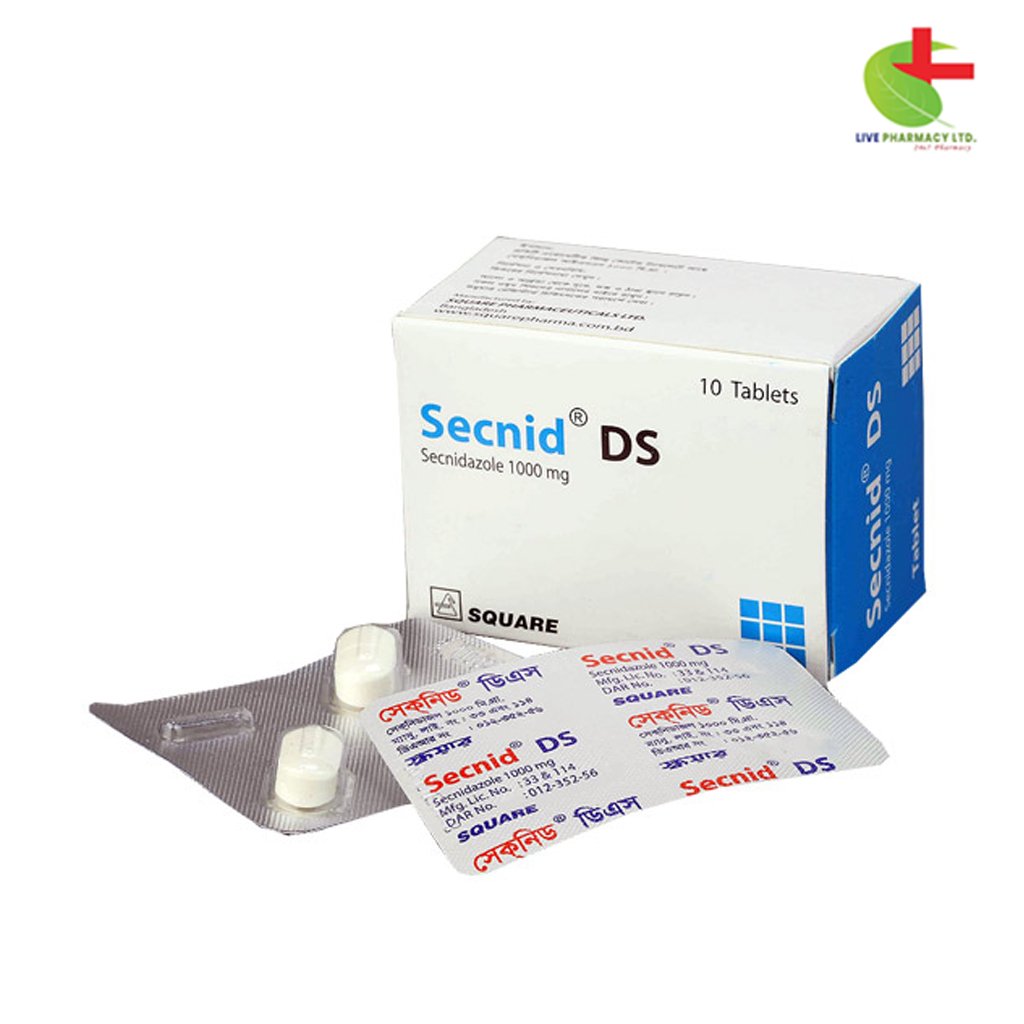Secnid DS
40.12৳ Strip
- Unveil Secnid DS: Your reliable remedy for gastrointestinal and protozoal infections.
- Swift absorption and extended therapeutic benefits ensure effective treatment for amoebiasis, giardiasis, and trichomoniasis.
- Oral administration minimizes side effects, offering relief without compromise.
- Trust for access to this essential medication, backed by reliability and quality assurance.
 Brand
Brand
|
Square Pharmaceuticals PLC |
|---|---|
 Generics
Generics
|
Secnidazole |
Indications
Secnid DS serves as an effective treatment for the following conditions:
- Intestinal Amoebiasis
- Hepatic Amoebiasis
- Urethritis and vaginitis caused by Trichomonas vaginalis
- Giardiasis
Pharmacology
Upon oral intake, Secnidazole is swiftly absorbed, reaching peak serum levels approximately three hours post-administration of a 2 gm dose. With a plasma elimination half-life of around 20 hours, the majority of Secnidazole is excreted through urine, with half of the ingested dose eliminated within 120 hours. Notably, Secnidazole boasts the longest half-life among second-generation nitroimidazoles, ensuring therapeutic blood levels for up to 72 hours following a single 2 gm dose.
Dosage & Administration
Secnidazole tablets are to be taken orally. The recommended dosage regimen is outlined below:
- Acute Intestinal Amoebiasis:
- Adults: A single 2 gm dose, preferably taken before meals.
- Children: A single dose of 30 mg/kg, preferably taken before meals.
- Asymptomatic Amoebiasis (minute & cystic form):
- Adults: 2 gm once daily for three days, preferably taken before meals.
- Children: 30 mg/kg once daily for three days, preferably taken before meals.
- Hepatic Amoebiasis: Concurrent evacuation of pus is essential during the suppurative stage of hepatic amoebiasis treatment with Secnidazole.
- Adults: 1.50 gm/day, administered in a single or divided dose before meals, for five days.
- Children: 30 mg/kg/day, administered in a single or divided dose before meals, for five days.
- Giardiasis:
- Adults: A single 2 gm dose, preferably taken before meals.
- Children: A single dose of 35-50 mg/kg, preferably taken before meals.
- Trichomoniasis:
- Adults: A single 2 gm dose, preferably taken before meals. Concurrent treatment for the partner is advised.
Interaction
- Avoid administering Secnid DS with disulfiram due to the potential for confusional state and paranoid reactions.
- Close monitoring is required when using Secnid DS alongside warfarin due to the increased effect of oral anticoagulants and the likelihood of increased hemorrhagic risk.
Contraindications
Secnidazole should not be used in patients hypersensitive to imidazole derivatives.
Side Effects
Clinical studies indicate excellent tolerance to Secnid DS with no reported serious adverse reactions. However, the following side effects, typical of nitroimidazole derivatives, may rarely occur:
- Common: Gastrointestinal disturbances, nausea, epigastric pain, metallic taste, glossitis, stomatitis.
- Occasional: Urticaria, reversible moderate leukopenia.
- Rare: Vertigo, ataxia, motor incoordination, paresthesia, peripheral neuropathy.
Pregnancy & Lactation
Secnidazole may be prescribed after the first trimester of pregnancy, but caution is advised as it crosses the placenta and is present in breast milk.
Precautions & Warnings:
- Patients are advised against alcohol consumption during Secnid DS treatment due to the possibility of an antabuse effect.
- Avoid administering Secnid DS to patients with a history of blood dyscrasia.
Therapeutic Class
Amoebicides, Anti-diarrhoeal Antiprotozoal
Storage Conditions
Keep Secnid DS in a cool, dry place, protected from heat.













Reviews
There are no reviews yet.